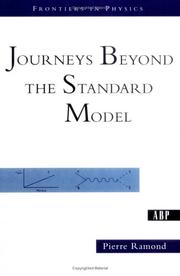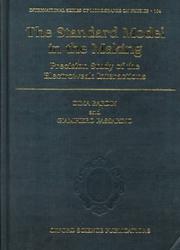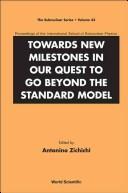| Listing 1 - 10 of 88 | << page >> |
Sort by
|
Book
ISBN: 9780691239101 069123910X Year: 2023 Publisher: Princeton: Princeton university press,
Abstract | Keywords | Export | Availability | Bookmark
 Loading...
Loading...Choose an application
- Reference Manager
- EndNote
- RefWorks (Direct export to RefWorks)
"Most of the data that is relevant for particle physics came from collider experiments. The task of particle physicists is to identify the patterns in this raw data, and to organize them in such a way that the principles that explain this variety emerge. The currently accepted theory of organization in particle physics is called the Standard Model (SM), which describes three of the four known fundamental forces and establishes principles of symmetry amongst particles. This book describes the SM as it is understood today, providing readers with a deep understanding of the symmetry principles at play in constructing models of particle physics. It is designed to be used as a textbook, accompanying a one semester course for graduate students. While generally presented as an optional elective, graduate-level courses on particle physics are common to most universities that offer a PhD in Physics. While there are variety of textbook offerings in the space, including our own Elementary Particle Physics in a Nutshell and The Standard Model in a Nutshell, this book is unique in its systematic and pedagogical approach, as well as for its inclusion of cosmological tests, which current texts lack. It also has a unique focus on model-building. Many of the other books on this topic attempt to cover a mix of QFT and the SM. This text focuses squarely on the Standard Model and does not attempt to concurrently teach QFT. Rather, it assumes some prior knowledge (while not requiring mastery of the subject). Lastly, the book will offer a greater number of homework-level practice problems than its counterparts."
Book
ISBN: 0691239118 Year: 2023 Publisher: Princeton, New Jersey : Princeton University Press,
Abstract | Keywords | Export | Availability | Bookmark
 Loading...
Loading...Choose an application
- Reference Manager
- EndNote
- RefWorks (Direct export to RefWorks)
"Most of the data that is relevant for particle physics came from collider experiments. The task of particle physicists is to identify the patterns in this raw data, and to organize them in such a way that the principles that explain this variety emerge. The currently accepted theory of organization in particle physics is called the Standard Model (SM), which describes three of the four known fundamental forces and establishes principles of symmetry amongst particles. This book describes the SM as it is understood today, providing readers with a deep understanding of the symmetry principles at play in constructing models of particle physics. It is designed to be used as a textbook, accompanying a one semester course for graduate students. While generally presented as an optional elective, graduate-level courses on particle physics are common to most universities that offer a PhD in Physics. While there are variety of textbook offerings in the space, including our own Elementary Particle Physics in a Nutshell and The Standard Model in a Nutshell, this book is unique in its systematic and pedagogical approach, as well as for its inclusion of cosmological tests, which current texts lack. It also has a unique focus on model-building. Many of the other books on this topic attempt to cover a mix of QFT and the SM. This text focuses squarely on the Standard Model and does not attempt to concurrently teach QFT. Rather, it assumes some prior knowledge (while not requiring mastery of the subject). Lastly, the book will offer a greater number of homework-level practice problems than its counterparts"-- "An authoritative, hands-on introduction to the foundational theory and experimental tests of particle physicsThe Standard Model is an elegant and extremely successful theory that formulates the laws of fundamental interactions among elementary particles. This incisive textbook introduces students to the physics of the Standard Model while providing an essential overview of modern particle physics, with a unique emphasis on symmetry principles as the starting point for constructing models. The Standard Model equips students with an in-depth understanding of this impressively predictive theory and an appreciation of its beauty, and prepares them to interpret future experimental results.Describes symmetry principles of growing complexity, including Abelian symmetries and their application in QED, the theory of electromagnetic interactions, non-Abelian symmetries and their application in QCD, the theory of strong interactions, and spontaneously broken symmetries and their application in the theory of weak interactionsDerives the Lagrangian that implements these symmetry principles and extracts the phenomenology that follows from it, such as elementary particles and accidental symmetriesExplains how the Standard Model has been experimentally tested, emphasizing electroweak precision measurements, flavor-changing neutral current processes, neutrino oscillations, and cosmologyDemonstrates how to extend the model to address experimental and observational puzzles, such as neutrino masses, dark matter, and the baryon asymmetry of the universeFeatures a wealth of problems drawing from the latest researchIdeal for a one-semester graduate course and an invaluable resource for practitionersOnline solutions manual (available only to instructors)"--

ISBN: 0813341310 9780813341316 Year: 2004 Volume: 101 Publisher: Boulder (Colo.) : Westview press,
Abstract | Keywords | Export | Availability | Bookmark
 Loading...
Loading...Choose an application
- Reference Manager
- EndNote
- RefWorks (Direct export to RefWorks)
This book should be at the side of every particle and nuclear physics graduate student and professional. 'Journeys Beyond the Standard Model' starts with a detailed and modern account of the Standard Model of elementary particle physics, the paradigm of particle physics for the last twenty years. Its timely release coincides with the recent dramatic discovery that the neutrino has a finite mass, which is the first indication that the Standard Model is an incomplete description of fundamental physics at short distances. This book presents in detail three possible generalizations of the Standard Model: its extension to accommodate neutrino masses; its extension to avoid CP violation in the strong interactions by introducing a new particle, the axion; and finally, its generalization to low-energy supersymmetry, which provides a link between the standard model and Einstein's theory of general relativity.This graduate text complements the author's previous book, 'Modern Field Theory: A Primer', which focuses on the methodology of particle physics. Its aim is to give students and professional physicists alike a thorough understanding of the phenomena described by the Standard Model, while keeping track of the most recent and cutting-edge principles of elementary particle physics.
Standard model (Nuclear physics) --- Neutrinos --- Supersymmetry --- Standard model (Nuclear physics).
Book
ISBN: 9290831162 Year: 1997 Publisher: Geneva CERN
Abstract | Keywords | Export | Availability | Bookmark
 Loading...
Loading...Choose an application
- Reference Manager
- EndNote
- RefWorks (Direct export to RefWorks)
Book
ISBN: 9789813227552 9813227559 Year: 2018 Publisher: New Jersey (N.J.): World scientific,
Abstract | Keywords | Export | Availability | Bookmark
 Loading...
Loading...Choose an application
- Reference Manager
- EndNote
- RefWorks (Direct export to RefWorks)
"The 2013 discovery of the Higgs boson posed a challenge to both physics undergraduates and their instructors. Since particle physics is seldom taught at the undergraduate level, the question "what is the Higgs and why does its discovery matter?" is a common question among undergraduates. Equally, answering this question is a problem for physics instructors. This book is an attempt to put the key concepts of particle physics together in an appealing way, and yet give enough extra tidbits for students seriously considering graduate studies in particle physics. It starts with some recapitulation of relativity and quantum mechanics, and then builds on it to give both conceptual ideas regarding the Standard Model of particle physics as well as technical details. It is presented in an informal lecture style, and includes "remarks" sections where extra material, history, or technical details are presented for the interested student. The last lecture presents an assessment of the open questions, and where the future might take us"--

ISBN: 9780198502807 019850280X Year: 1999 Publisher: Oxford: Clarendon,
Abstract | Keywords | Export | Availability | Bookmark
 Loading...
Loading...Choose an application
- Reference Manager
- EndNote
- RefWorks (Direct export to RefWorks)
Standard model (Nuclear physics) --- Electroweak interactions
Book
ISBN: 9810206852 Year: 1991 Publisher: Singapore : World Scientific,
Abstract | Keywords | Export | Availability | Bookmark
 Loading...
Loading...Choose an application
- Reference Manager
- EndNote
- RefWorks (Direct export to RefWorks)

ISBN: 1281937940 9786611937942 9812779124 9789812779120 9789812779113 9812779116 Year: 2007 Volume: v. 43 Publisher: Singapore Hackensack, NJ World Scientific
Abstract | Keywords | Export | Availability | Bookmark
 Loading...
Loading...Choose an application
- Reference Manager
- EndNote
- RefWorks (Direct export to RefWorks)
This volume is a collection of lectures given by distinguished physicists from around the world, covering the most recent advances in theoretical physics and the latest results from current experimental facilities. Following one of the principal aims of the School - to encourage and promote young physicists to achieve recognition at an international level - the students who distinguished themselves for the excellence of their research were given the opportunity to publish their presentations in this volume. Sample Chapter(s)
Chapter 1: Experimental Signatures of Strings and Branes
Book
Year: 2017 Publisher: Princeton, NJ : Princeton University Press,
Abstract | Keywords | Export | Availability | Bookmark
 Loading...
Loading...Choose an application
- Reference Manager
- EndNote
- RefWorks (Direct export to RefWorks)
A concise introduction to the cutting-edge science of particle physicsThe standard model of particle physics describes our current understanding of nature's fundamental particles and their interactions, yet gaps remain. For example, it does not include a quantum theory of gravity, nor does it explain the existence of dark matter. Once complete, however, the standard model could provide a unified description of the very building blocks of the universe. Researchers have been chasing this dream for decades, and many wonder whether such a dream can ever be made a reality.Can the Laws of Physics Be Unified? is a short introduction to this exciting frontier of physics. The book is accessibly written for students and researchers across the sciences, and for scientifically minded general readers. Paul Langacker begins with an overview of the key breakthroughs that have shaped the standard model, and then describes the fundamental particles, their interactions, and their role in cosmology. He goes on to explain field theory, internal symmetries, Yang-Mills theories, strong and electroweak interactions, the Higgs boson discovery, and neutrino physics. Langacker then looks at the questions that are still unanswered: What is the nature of the mysterious dark matter and dark energy that make up roughly 95 percent of the universe? Why is there more matter than antimatter? How can we reconcile quantum mechanics and general relativity?Can the Laws of Physics Be Unified? describes the promising theoretical ideas and new experiments that could provide answers and weighs our prospects for establishing a truly unified theory of the smallest constituents of nature and their interactions.
Book
ISBN: 1009187139 1009171593 Year: 2023 Publisher: Cambridge : Cambridge University Press,
Abstract | Keywords | Export | Availability | Bookmark
 Loading...
Loading...Choose an application
- Reference Manager
- EndNote
- RefWorks (Direct export to RefWorks)
This is a modern introduction to the Standard Model of particle physics for graduate students and advanced undergraduate students. Assuming only prior knowledge of special relativity and non-relativistic quantum mechanics, it presents all aspects of the field, including step-by-step explanations of the theory and the most recent experimental results. Taking a pedagogical, first-principles approach, it demonstrates the essential tools for students to process and analyse experimental particle physics data for themselves.
| Listing 1 - 10 of 88 | << page >> |
Sort by
|

 Search
Search Feedback
Feedback About UniCat
About UniCat  Help
Help News
News